|
The
final
contemporary
program
of
the
season
was
divided
in
the
usual
threesome:
First
Helgi
Tomasson,
followed
by
Myles
Thatcher
with
a
world
première,
then
William
Forsythe.
Tomasson, Seven For Eight
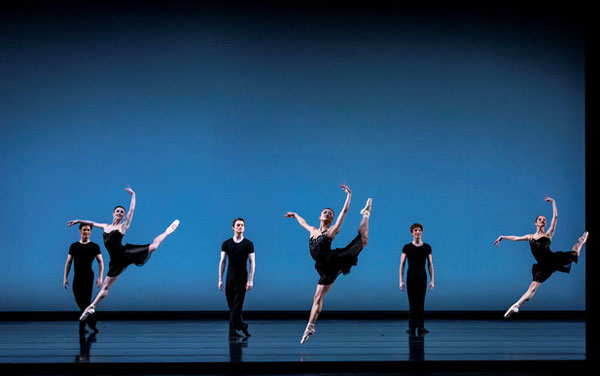
This piece by the retired artistic director of SF Ballet is one of his finest
neo-classical choreographies. Created in 2004, it has appeared frequently
on the program (reviewed in these pages). Set to seven short extracts from
Johann Sebastian Bach's compositions, it presents an elegant structure for
eight dancers: each segment focuses on a couple, a trio, two couples, a solo,
another pas de deux and finally, the ensemble. Having watched the
numerous group choreographies of this season's Next@90 Festival of new
works, the effect of a ballet that consists of "solo turns" was refreshing. The
movements have a beautiful, understated fluidity throughout, with some
emotional depth and some playfulness, all danced with superb lines by the
cast.
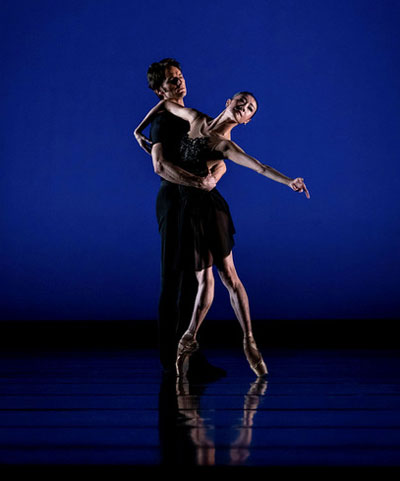
Yuan Yuan Tan, the prima ballerina assoluta of SF Ballet, has danced the
two romantic pas de deux from the moment of their creation, and she is
still incomparable in her lyrical, highly musical grace, her thrilling
extensions and her long, expressive feet. She was tenderly partnered by
Aaron Robison. Also outstanding was Max Cauthorn in a solo of leaps and
turns. The beauty of the piece was enhanced by the costumes: everyone
dressed in black, the skirts thigh-length – another touch of high-style
understatement. The enthusiastic applause confirmed that classy neo
-classical ballet, several generations after Balanchine, can still excite.
Myles Thatcher, Colorforms
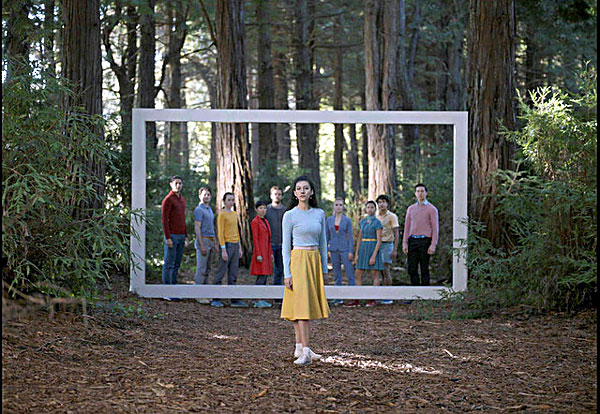
Myles Thatcher, a young soloist and one of SF Ballet's "own"
choreographers, supplied the title of the soirée with his short ballet film Colorforms from 2021, directed by Ezra Hurwitz. That year, in the middle
of Covid lock-down, Thatcher had the inspired idea of taking a group of ten
dancers (partly corps members) out into SF MOMA, the Museum of
Modern Art, and into the Californian redwoods -- to let loose, gambol, and
find a fresh footing. The result was an enchanting romp in exquisite colors
with contemplative moments of quiet – a golden Gingko tree on the
museum roof, a dancer in a window sketching the tree, faces in closeup,
bodies in repose on a museum bench, and the beauty of paper airplanes in
flight.
|
Colorforms Film

|
Bringing this cornucopia to the limited space of the stage was of course a
challenge and the ballet suffered by comparison. Lost was the poetry of
contemplation, the vast breath of nature, the closer focus on personalities.
The continuous ensemble romp with outbreaks of solos, pas de deux or sub
groups seemed flattened by the abstract space and did not evoke the same
emotion. Even Steve Reich's Variations for Vibes, Strings and Piano with
their repetitive dissonances seemed to have lost some of their drive.
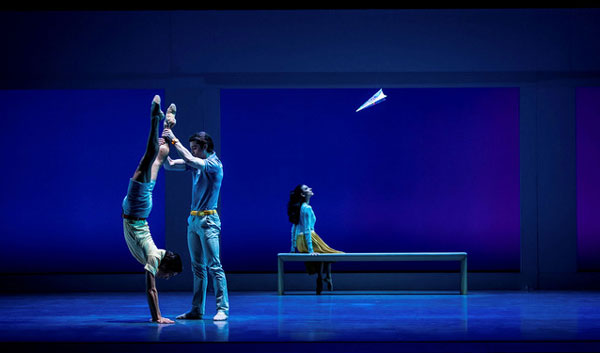
Thatcher's initial inspiration for Colorforms had been Calder's gigantic
mobiles at SF MOMA. In interviews he talked about his fascination with the
connectivity between all pieces of the mobile and their reverberations
when you touched any one element. He transposed this symbol of
connection particularly well in the daisy chains: with all the dancers linked
through their arms, their movement impulses vibrated and beautifully
rippled through the group.

In the film version, a huge picture frame placed in the redwoods had a
stunning effect of contrasting the immobility of the group and trees in the
frame with the energy of one dancer (the graceful soloist Jasmine Jimison)
breaking through the nature/culture boundary. Onstage, the effect of the
frame was lukewarm. Still, the fundamental theme of community
connection came across and, with its feast of colors, had a seductive
playfulness. Thatcher's easy mix of everyday moves and at times jazzy
contemporary styles was highlighted through the charming costume
changes -- from hip everyday garb and chic sneakers to diverse classroom
attires and pointe shoes. The ten dancers were all impeccable and clearly
enjoyed each other and themselves as much as the audience did.
William Forsythe, Blake Works I
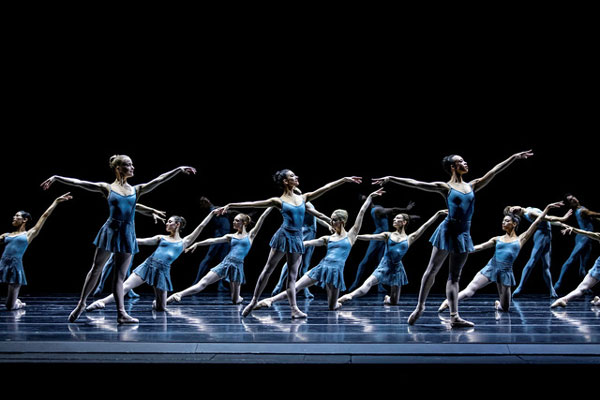
I was eager to see Blake Works I (from 2016) since an excerpt was
presented at the opening gala in December: a pas de deux set to a moody
pop songs by British singer/songwriter James Blake. The fluid naturalness
of the relationship between the dancers (Nikisha Fogo and Isaac
Hernandez ), the constant inventiveness of the steps and musical phrases
revealed the master of contemporary ballet, William Forsythe.
|
Blake Works pas de deux
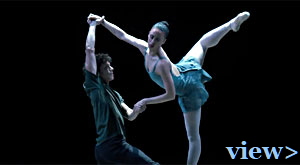
|
Forsythe (born in 1949) is familiar to the company thanks to Helgi
Tomasson's invitation of major works by the choreographer over the years.
To name a few: in the middle, slightly elevated, followed by The
Vertiginous Thrill of Exactitude, and Artifact Suite (reviewed in these
pages). Every one of these works was a milestone in the adventurous
development of what one might call post-post-Balanchine vocabulary.
Forsythe's style fascinated and influenced the ballet world with daring off
-balances, point-counterpoint "combat" moves, extreme leg extensions and
neck-breaking speed, often set to Thom Willems's electronic, hammering
beat.
"Classical ballet is like a tattoo, you can't rub it off," Forsythe said in an
interview. With his evening-length Blake Works from 2016 he has made a
slight u-turn from the edge of experimentation. He seems to embrace and
re-color the tattoo in a neo-classicism that brilliantly confirms him as the
Balanchine of our time.
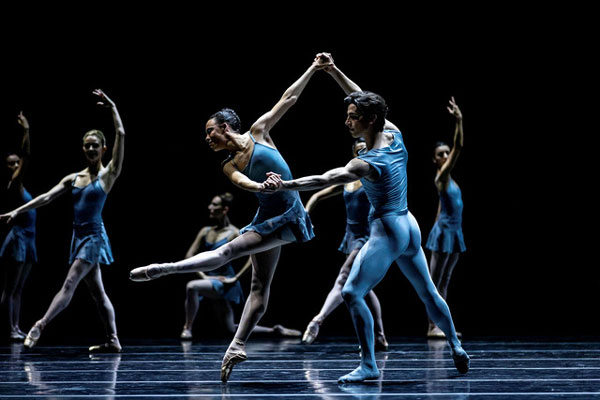
Seven songs from James Blake's album The Color in Anything set very
different moods from tender, aching yearning to propulsive explosions of
electronic beat. The twenty-six dancers showcased their relaxed virtuosity
in Forsythe's demanding speed and sophisticated, often syncopated
phrases. Watching excerpts from other top ballet companies doing the
same pieces, I found that SF Ballet stands out as one of the best.
Forsythe is also a musician – another parallel with Balanchine – and also
has his hand in every element of the performance, costumes, stage sets and
lights. Forsythe's group movements never seem chaotic or losing a firm
structural pull. He achieves this with rhythmically recurring steps and
prominent arm movements that continuously reestablish a group cohesion.
Seeing large groups of dancers in turbulent moves – especially in Blake's "I
Hope I'm Right" – while they still keep a marked structure transparent, is
the kind of aesthetic pleasure that language revolutionary Gertrude Stein
would have called "peaceful and exciting."
It is also pure Balanchine.
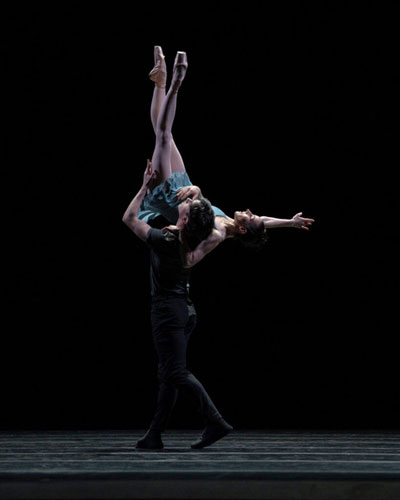
A high point was once again the pas de deux. Set to Blake's dreamy title
song "The color in everything," it was performed by Julia Rowe and
Esteban Hernandez who rendered the intricate steps with such ease and
charm that the audience seemed spell-bound. The ballet convention of the
pas de deux, the male-female partnering that can so easily be a yawning
bore, was reinvented by Forsythe into something brand-new and hard to
define. Certainly, there were all the steps of the canon but in Forsythe's
handling you forgot that you had ever seen them before.
All photos SF Ballet Lindsay Thomas
|